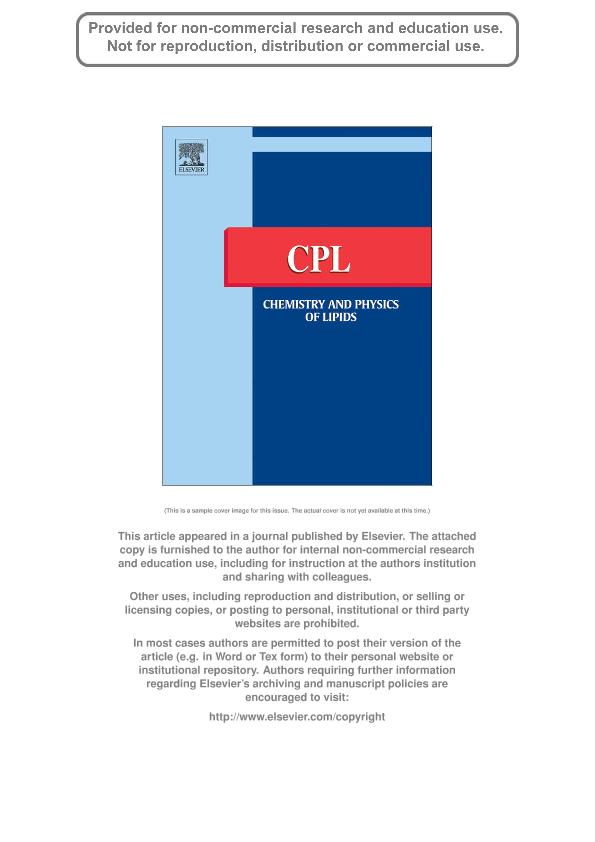Artículo
Structural effect of cationic amphiphiles in diacetylenic photopolymerizable membranes
Temprana, Carlos Facundo ; Duarte, Evandro L.; Femia, Lis
; Duarte, Evandro L.; Femia, Lis ; Alonso, Silvia del Valle
; Alonso, Silvia del Valle ; Lamy, M. Teresa
; Lamy, M. Teresa
 ; Duarte, Evandro L.; Femia, Lis
; Duarte, Evandro L.; Femia, Lis ; Alonso, Silvia del Valle
; Alonso, Silvia del Valle ; Lamy, M. Teresa
; Lamy, M. Teresa
Fecha de publicación:
12/2012
Editorial:
Elsevier Ireland
Revista:
Chemistry and Physics of Lipids
ISSN:
0009-3084
Idioma:
Inglés
Tipo de recurso:
Artículo publicado
Clasificación temática:
Resumen
Liposomes have been an excellent option as drug delivery systems, since they are able of incorporating lipophobic and/or lipophilic drugs, reduce drug side effects, increase drug targeting, and control delivery. Also, in the last years, their use reached the field of gene therapy, as non-viral vectors for DNA delivery. As a strategy to increase system stability, the use of polymerizable phospholipids has been proposed in liposomal formulations. In this work, through differential scanning calorimetry (DSC) and electron spin resonance (ESR) of spin labels incorporated into the bilayers, we structurally characterize liposomes formed by a mixture of the polymerizable lipid diacetylenic phosphatidylcholine 1,2-bis(10,12-tricosadiynoyl)-sn-glycero-3-phosphocholine (DC8,9PC) and the zwitterionic lipid 1,2-dimyristoyl-sn-glycero-3- phosphocholine (DMPC), in a 1:1 molar ratio. It is shown here that the polymerization efficiency of the mixture (c.a. 60%) is much higher than that of pure DC8,9PC bilayers (c.a. 20%). Cationic amphiphiles (CA) were added, in a final molar ratio of 1:1:0.2 (DC8,9PC:DMPC:CA), to make the liposomes possible carriers for genetic material, due to their electrostatic interaction with negatively charged DNA. Three amphiphiles were tested, 1,2-dioleoyl-3-trimetylammonium-propane (DOTAP), stearylamine (SA) and trimetyl (2-miristoyloxietyl) ammonium chloride (MCL), and the systems were studied before and after UV irradiation. Interestingly, the presence of the cationic amphiphiles increased liposomes polymerization, MCL displaying the strongest effect. Considering the different structural effects the three cationic amphiphiles cause in DC8,9PC bilayers, there seem to be a correlation between the degree of DC8,9PC polymerization and the packing of the membrane at the temperature it is irradiated (gel phase). Moreover, at higher temperatures, in the bilayer fluid phase, more polymerized membranes are significantly more rigid. Considering that the structure and stability of liposomes at different temperatures can be crucial for DNA binding and delivery, we expect the study presented here contributes to the production of new carrier systems with potential applications in gene therapy.
Palabras clave:
CATIONIC AMPHIPHILE
,
DIACETYLENIC LIPID
,
DSC
,
ESR
,
POLYMERIC LIPOSOME
,
SPIN LABEL
Archivos asociados
Licencia
Identificadores
Colecciones
Articulos(IMBICE)
Articulos de INST.MULTIDISCIPL.DE BIOLOGIA CELULAR (I)
Articulos de INST.MULTIDISCIPL.DE BIOLOGIA CELULAR (I)
Articulos(INTEC)
Articulos de INST.DE DES.TECNOL.PARA LA IND.QUIMICA (I)
Articulos de INST.DE DES.TECNOL.PARA LA IND.QUIMICA (I)
Articulos(SEDE CENTRAL)
Articulos de SEDE CENTRAL
Articulos de SEDE CENTRAL
Citación
Temprana, Carlos Facundo; Duarte, Evandro L.; Femia, Lis; Alonso, Silvia del Valle; Lamy, M. Teresa; Structural effect of cationic amphiphiles in diacetylenic photopolymerizable membranes; Elsevier Ireland; Chemistry and Physics of Lipids; 165; 5; 12-2012; 589-600
Compartir
Altmétricas



